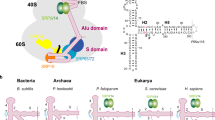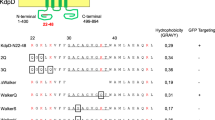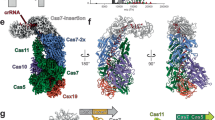Abstract
The signal recognition particle (SRP) is a phylogenetically conserved ribonucleoprotein. It associates with ribosomes to mediate co-translational targeting of membrane and secretory proteins to biological membranes. In mammalian cells, the SRP consists of a 7S RNA and six protein components. The S domain of SRP comprises the 7S.S part of RNA bound to SRP19, SRP54 and the SRP68/72 heterodimer; SRP54 has the main role in recognizing signal sequences of nascent polypeptide chains and docking SRP to its receptor1,2,3. During assembly of the SRP, binding of SRP19 precedes and promotes the association of SRP54 (refs 4, 5). Here we report the crystal structure at 2.3 Å resolution of the complex formed between 7S.S RNA and SRP19 in the archaeon Methanococcus jannaschii. SRP19 bridges the tips of helices 6 and 8 of 7S.S RNA by forming an extensive network of direct protein–RNA interactions. Helices 6 and 8 pack side by side; tertiary RNA interactions, which also involve the strictly conserved tetraloop bases, stabilize helix 8 in a conformation competent for SRP54 binding. The structure explains the role of SRP19 and provides a molecular framework for SRP54 binding and SRP assembly in Eukarya and Archaea.
This is a preview of subscription content, access via your institution
Access options
Subscribe to this journal
Receive 51 print issues and online access
$199.00 per year
only $3.90 per issue
Buy this article
- Purchase on Springer Link
- Instant access to full article PDF
Prices may be subject to local taxes which are calculated during checkout





Similar content being viewed by others
References
Lütcke, H. Signal recognition particle (SRP), a ubiquitous initiator of protein translocation. Eur. J. Biochem. 228, 531–550 (1995)
Keenan, R. J., Freymann, D. M., Stroud, R. M. & Walter, P. The signal recognition particle. Annu. Rev. Biochem. 70, 755–775 (2001)
Wild, K., Weichenrieder, O., Strub, K., Sinning, I. & Cusack, S. Towards the structure of the mammalian signal recognition particle. Curr. Opin. Struct. Biol. 12, 72–81 (2002)
Walter, P. & Blobel, G. Disassembly and reconstitution of signal recognition particle. Cell 34, 525–533 (1983)
Politz, J. C. et al. Signal recognition particle components in the nucleolus. Proc. Natl Acad. Sci. USA 97, 55–60 (2000)
Gorodkin, J., Knudsen, B., Zwieb, C. & Samuelsson, T. SRPDB (Signal Recognition Particle Database). Nucleic Acids Res. 29, 169–170 (2001)
Bhuiyan, S. H., Gowda, K., Hotokezaka, H. & Zwieb, C. Assembly of archaeal signal recognition particle from recombinant components. Nucleic Acids Res. 28, 1365–1373 (2000)
Zwieb, C. Recognition of a tetranucleotide loop of signal recognition particle RNA by protein SRP19. J. Biol. Chem. 267, 15650–15656 (1992)
Zwieb, C. Site-directed mutagenesis of signal-recognition particle RNA. Identification of the nucleotides in helix 8 required for interaction with protein SRP19. Eur. J. Biochem. 222, 885–890 (1994)
Diener, J. L. & Wilson, C. Role of SRP19 in assembly of the Archaeoglobus fulgidus signal recognition particle. Biochemistry 39, 12862–12874 (2000)
Rose, M. A. & Weeks, K. M. Visualizing induced fit in early assembly of the human signal recognition particle. Nature Struct. Biol. 8, 515–520 (2001)
Wild, K., Sinning, I. & Cusack, S. Crystal structure of an early protein–RNA assembly complex of the signal recognition particle. Science 294, 598–601 (2001)
Batey, R. T., Rambo, R. P., Lucast, L., Rha, B. & Doudna, J. A. Crystal structure of the ribonucleoprotein core of the signal recognition particle. Science 287, 1232–1239 (2000)
Weichenrieder, O., Wild, K., Strub, K. & Cusack, S. Structure and assembly of the Alu domain of the mammalian signal recognition particle. Nature 408, 167–173 (2000)
Uhlenbeck, O. C. Tetraloops and RNA folding. Nature 346, 613–614 (1990)
Jucker, F. M., Heus, H. A., Yip, P. F., Moors, E. H. & Pardi, A. A network of heterogeneous hydrogen bonds in GNRA tetraloops. J. Mol Biol. 264, 968–980 (1996)
Jovine, L. et al. Crystal structure of the ffh and EF-G binding sites in the conserved domain IV of Escherichia coli 4.5S RNA. Struct. Fold. Des. 8, 527–540 (2000)
Correll, C. C., Freeborn, B., Moore, P. B. & Steitz, T. A. Metals, motifs, and recognition in the crystal structure of a 5S rRNA domain. Cell 91, 705–712 (1997)
Agalarov, S. C., Prasad, G. S., Funke, P. M., Stout, C. D. & Williamson, J. R. Structure of the S15,S6,S18-rRNA complex: Assembly of the 30S ribosome central domain. Science 288, 107–112 (2000)
Price, S. R., Ito, N., Oubridge, C., Avis, J. M. & Nagai, K. Crystallization of RNA–protein complexes. I. Methods for the large-scale preparation of RNA suitable for crystallographic studies. J. Mol. Biol. 249, 398–408 (1995)
Otwinowski, Z. & Minor, W. Processing of X-ray diffraction data collected in oscillation mode. Methods Enzymol. 276, 307–326 (1997)
Collaborative Computational Project No. 4. The CCP4 suite: programs for protein crystallography. Acta Crystallogr. D 50, 760–763 (1994)
Wild, K., Weichenrieder, O., Leonard, G. A. & Cusack, S. The 2 Å structure of helix 6 of the human signal recognition particle RNA. Struct. Fold. Des. 7, 1345–1352 (1999)
Brünger, A. T. et al. Crystallography & NMR system: A new software suite for macromolecular structure determination. Acta Crystallogr. D 54, 905–921 (1998)
Jones, T. A., Zou, J. Y., Cowan, S. W. & Kjeldgaard Improved methods for binding protein models in electron density maps and the location of errors in these models. Acta Crystallogr. A 47, 110–119 (1991)
Brünger, A. T. Free R value: a novel statistical quantity for assessing the accuracy of crystal structures. Nature 355, 472–474 (1992)
Abagyan, R. A., Totrov, M. M. & Kuznetsov, D. N. ICM—a new method for protein modelling and design. Application to docking and structure prediction from the distorted native conformation. J. Comput. Chem. 15, 488–506 (1994)
Harris, M. & Jones, T. A. Molray—a web interface between O and the POV-Ray ray tracer. Acta Crystallogr. D 57, 1201–1203 (2001)
Clemons, W. M. Jr, Gowda, K., Black, S. D., Zwieb, C. & Ramakrishnan, V. Crystal structure of the conserved subdomain of human protein SRP54M at 2.1 Å resolution: evidence for the mechanism of signal peptide binding. J. Mol Biol. 292, 697–705 (1999)
Acknowledgements
We thank K. O. Stetter for providing M. jannaschii cells; C. Oubridge for T7 polymerase; and U. H. Sauer and T. Bergfors for suggestions to the manuscript. This work was supported by the Swedish Research Council and European Union. We thank K. Nagai and the Medical Research Council UK for their support at an early stage of this project.
Author information
Authors and Affiliations
Corresponding author
Ethics declarations
Competing interests
The authors declare that they have no competing financial interests.
Rights and permissions
About this article
Cite this article
Hainzl, T., Huang, S. & Sauer-Eriksson, A. Structure of the SRP19–RNA complex and implications for signal recognition particle assembly. Nature 417, 767–771 (2002). https://doi.org/10.1038/nature00768
Received:
Accepted:
Published:
Issue Date:
DOI: https://doi.org/10.1038/nature00768
This article is cited by
-
Genetic Discrimination of Grade 3 and Grade 4 Gliomas by Artificial Neural Network
Cellular and Molecular Neurobiology (2024)
-
The Archaeal Signal Recognition Particle: Present Understanding and Future Perspective
Current Microbiology (2017)
-
Structural insights into recognition of c-di-AMP by the ydaO riboswitch
Nature Chemical Biology (2014)
-
Plasmodium falciparum signal recognition particle components and anti-parasitic effect of ivermectin in blocking nucleo-cytoplasmic shuttling of SRP
Cell Death & Disease (2014)
-
Structural basis of signal-sequence recognition by the signal recognition particle
Nature Structural & Molecular Biology (2011)
Comments
By submitting a comment you agree to abide by our Terms and Community Guidelines. If you find something abusive or that does not comply with our terms or guidelines please flag it as inappropriate.



